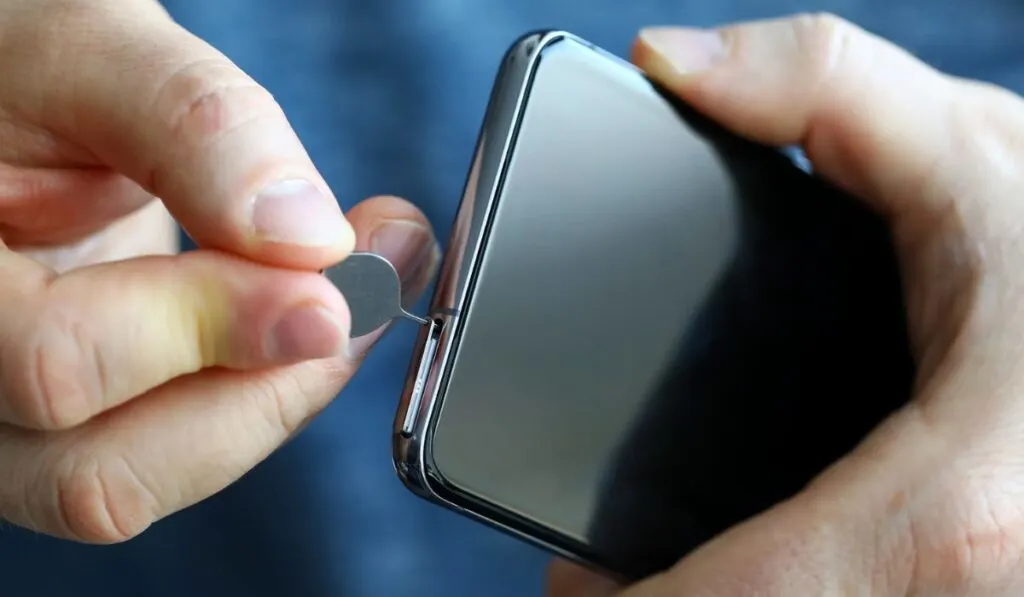If you change carriers or intend to sell your iPhone, you may need to remove the SIM card. Unfortunately, removing a SIM card can be intimidating if you’ve never done it before. Thankfully, the process is incredibly straightforward and takes no time at all.
First, ensure your device is turned off. Next, locate the SIM card tray on your iPhone and open it with a SIM card tool or paper clip. Carefully remove the tray and set the new SIM card on it. Gently insert the tray with the new SIM card into the iPhone until you hear a click.
Don’t panic if you need to swap SIM cards and aren’t sure what to do. This process is straightforward, but there are a few considerations to keep in mind. We cover everything you need to know in the article below.
What is a SIM Card?
A Subscriber Identity Module or SIM card is a small, portable memory chip that holds information about the cell phone user. SIM cards include a seventeen-digit code that indicates the country of origin, the carrier (such as T-Mobile or Version), and a unique user ID.
Phone carriers use SIM cards to assign cell phone bills and charge users. SIM cards are handy as they can be easily transferred to new devices while maintaining most of your contacts, settings, and information. Without a SIM card, you may not have the option to make calls, connect to 4G LTE networks, or send SMS messages.
Can You Swap SIM Cards Between iPhones?

Yes, it’s entirely possible to swap SIM cards between iPhones. However, there are a few considerations to keep in mind, including the following:
- Your iPhone must be unlocked if you plan to use a SIM card from a different carrier. If you purchased your new device from Apple, it’s most likely unlocked. However, it’s usually locked if you bought your iPhone from a carrier.
- Unlike other devices, iPhones do not store contact information on the SIM card. Instead, iPhones back up data to iCloud. So before swapping SIM cards in an iPhone, you’ll need to back up contacts, photos, text messages, and other personal information to iCloud or your memory card.
- You must use a nano-SIM card. All iPhone models since 2012 have used nano-SIM cards, the smallest option available. However, some models still use micro-SIM cards, so you’ll need to check beforehand.
What is Stored on a SIM Card?
Depending on the model and carrier, SIM cards typically have enough memory to store over 200 contacts and several text conversations. SIM cards also include the following:
- User identification
- Location and country of origin
- Phone number
- Network authorization information
- Personal security keys
What is Not Stored on a SIM Card?
Most SIM cards do not store personal photos, files, or applications, meaning you’ll have to back these up ahead of time. However, unlike other devices, iPhones do not store contact information on the SIM card. Instead, iPhones back up data to iCloud.
Before swapping SIM cards in an iPhone, you’ll need to back up contacts, photos, text messages, and other personal information to iCloud or your memory card.
How Do You Remove a SIM Card?
Removing a SIM card on an iPhone is a straightforward process. Depending on your model, first, the SIM card tray is placed on the left or right side. The SIM card slot looks like a tiny, raised port with a pinhole next to it. After turning off your device, follow these steps to remove your iPhone SIM card.
Step 1: Insert the SIM Card Tool
The first step is to insert the SIM card removal tool into the pinhole. If you don’t have a removal tool, you can use a straightened paper clip or the back of an earring. Firmly insert the removal tool into the pinhole until you hear or feel a click. After you notice a click, the SIM card tray will pop outward.
Step 2: Remove the SIM Card
The second step is to remove the SIM card. The SIM card should come out of the tray without any force. If stuck, your SIM card tray may be bent or damaged. Do not use tweezers or other tools to knock out the card, as you may cause damage to the card. Ensure you store your SIM card somewhere safe where it won’t be damaged.
How to Insert a SIM Card into an iPhone

Inserting a SIM card into an iPhone is a straightforward process, and you can follow the steps below to start:
- Turn off your iPhone and open the SIM card tray with a removal tool. You can follow the steps mentioned above to open the SIM card tray. Make sure you pull the tray all the way out before step two.
- Locate the correct corner of the SIM card. One of the edges of the SIM card should be “clipped.” Match the edges of the SIM card with the space on the tray.
- Finally, carefully place the SIM card onto the tray and insert the tray into your iPhone. Don’t force it, and avoid touching the gold portion of the SIM, as you may cause damage. You’ll notice a click after you slide the tray into your iPhone.
Your device should boot up and work as expected after inserting the new SIM card. Turn off your phone and repeat the steps if you encounter any issues.
